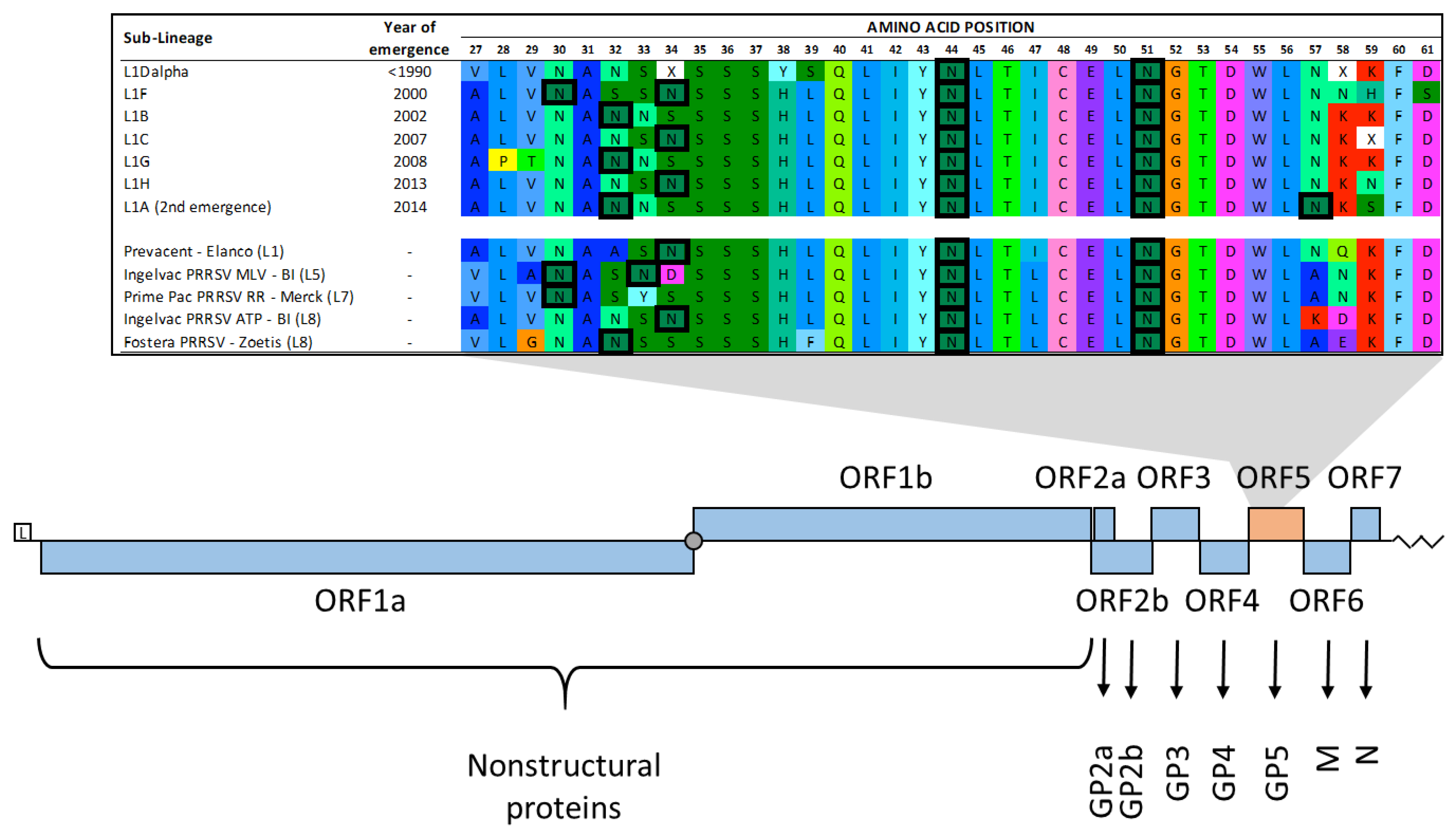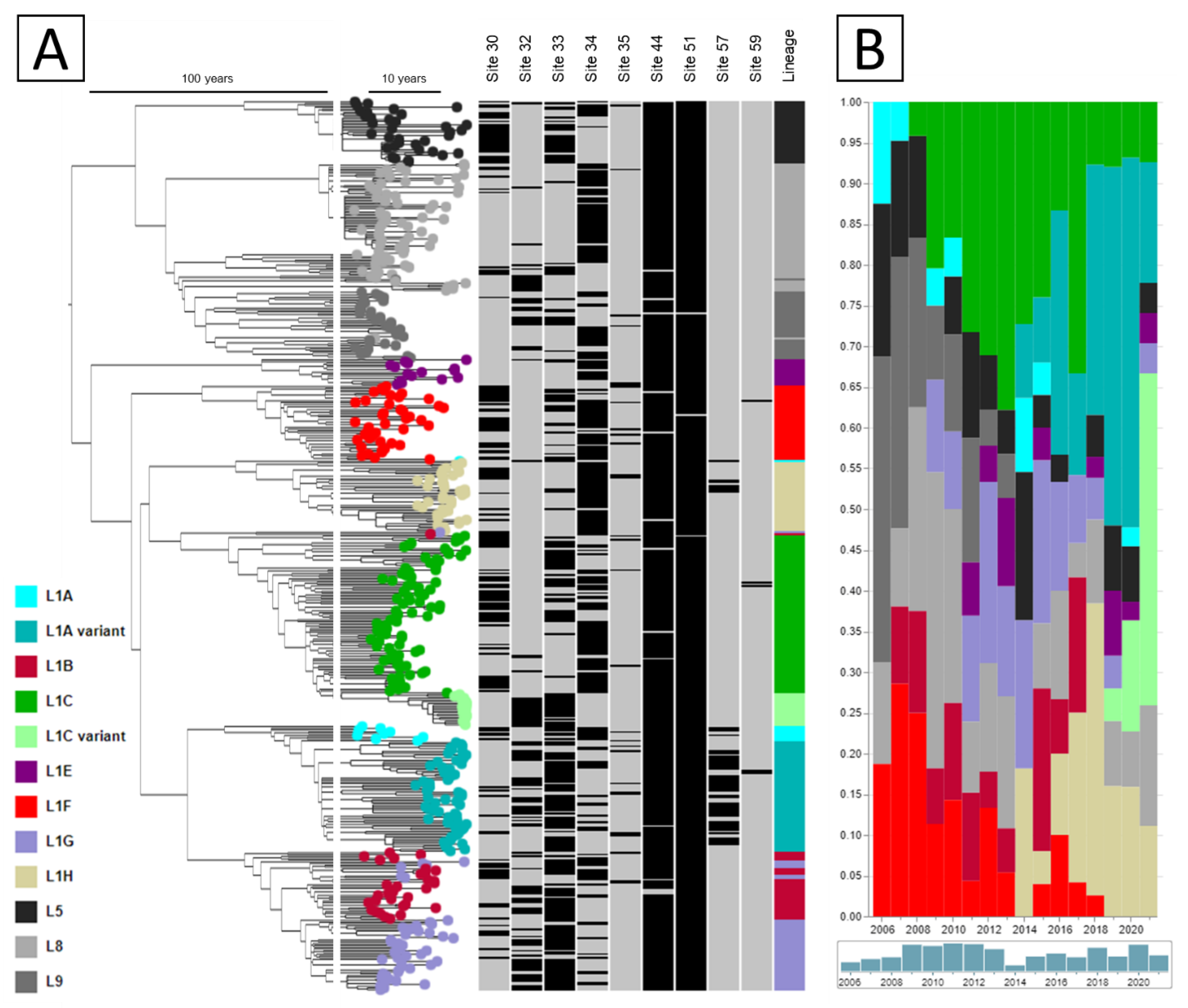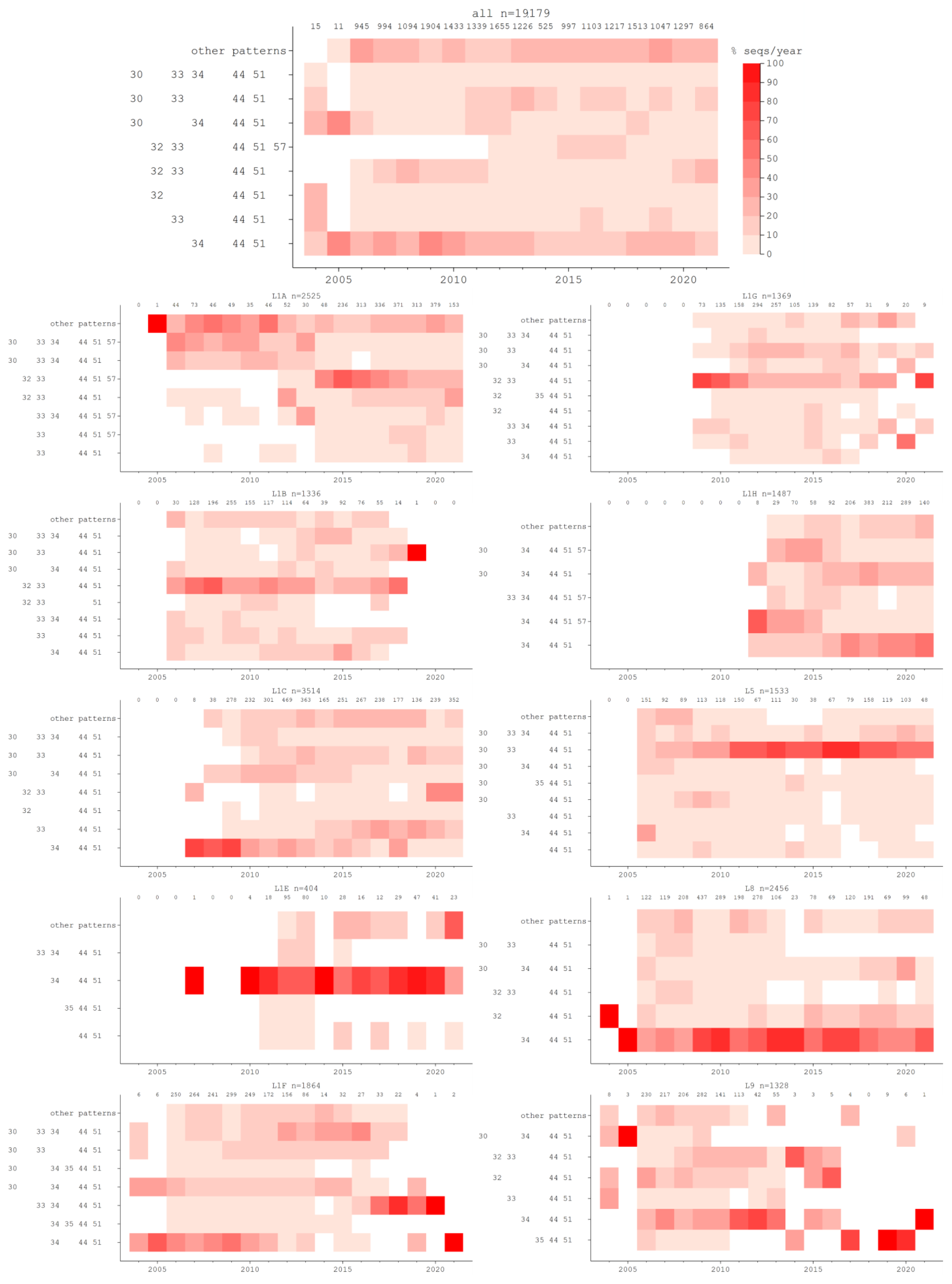Potential Novel N-Glycosylation Patterns Associated with the Emergence of New Genetic Variants of PRRSV-2 in the U.S
Abstract
1. Introduction
2. Materials and Methods
3. Results and Discussion
Supplementary Materials
Author Contributions
Funding
Institutional Review Board Statement
Informed Consent Statement
Data Availability Statement
Acknowledgments
Conflicts of Interest
References
- Lisowska, E. The role of glycosylation in protein antigenic properties. Cell. Mol. Life Sci. 2002, 59, 445–455. Available online: http://www.ncbi.nlm.nih.gov/pubmed/11964123 (accessed on 19 August 2022).
- Reily, C.; Stewart, T.J.; Renfrow, M.B.; Novak, J. Glycosylation in health and disease. Nat. Rev. Nephrol. 2019, 15, 346–366. Available online: http://www.nature.com/articles/s41581-019-0129-4 (accessed on 19 August 2022).
- Price, J.L.; Powers, D.L.; Powers, E.T.; Kelly, J.W. Glycosylation of the enhanced aromatic sequon is similarly stabilizing in three distinct reverse turn contexts. Proc. Natl. Acad. Sci. USA 2011, 108, 14127–14132. Available online: https://pnas.org/doi/full/10.1073/pnas.1105880108 (accessed on 19 August 2022). [CrossRef] [PubMed]
- Watanabe, Y.; Bowden, T.A.; Wilson, I.A.; Crispin, M. Exploitation of glycosylation in enveloped virus pathobiology. Biochim. Biophys. Acta (BBA)-Gen. Subj. 2019, 1863, 1480–1497. Available online: https://linkinghub.elsevier.com/retrieve/pii/S0304416519301333 (accessed on 19 August 2022). [CrossRef]
- Gruszewska, E.; Grytczuk, A.; Chrostek, L. Glycosylation in viral hepatitis. Biochim. Biophys. Acta (BBA)-Gen. Subj. 2021, 1865, 129997. Available online: https://linkinghub.elsevier.com/retrieve/pii/S0304416521001562 (accessed on 19 August 2022). [CrossRef] [PubMed]
- Stewart-Jones, G.B.; Soto, C.; Lemmin, T.; Chuang, G.-Y.; Druz, A.; Kong, R.; Thomas, P.V.; Wagh, K.; Zhou, T.; Behrens, A.-J.; et al. Trimeric HIV-1-Env Structures Define Glycan Shields from Clades A, B, and G. Cell 2016, 165, 813–826. Available online: https://linkinghub.elsevier.com/retrieve/pii/S0092867416304019 (accessed on 19 August 2022). [CrossRef]
- Crispin, M.; Ward, A.B.; Wilson, I.A. Structure and Immune Recognition of the HIV Glycan Shield. Annu. Rev. Biophys. 2018, 47, 499–523. Available online: https://www.annualreviews.org/doi/10.1146/annurev-biophys-060414-034156 (accessed on 19 August 2022). [CrossRef]
- Watanabe, Y.; Allen, J.D.; Wrapp, D.; McLellan, J.S.; Crispin, M. Site-specific glycan analysis of the SARS-CoV-2 spike. Science 2020, 369, 330–333. Available online: https://www.science.org/doi/10.1126/science.abb9983 (accessed on 19 August 2022). [CrossRef] [PubMed]
- Holtkamp, D.J.; Kliebenstein, J.B.; Neumann, E.J.; Zimmerman, J.J.; Rotto, H.F.; Yoder, T.K.; Wang, C.; Yeske, P.E.; Mowrer, C.L.; Haley, C.A. Assessment of the economic impact of porcine reproductive and respiratory syndrome virus on United States pork producers. J. Swine Health Prod. 2013, 21, 72–84. Available online: http://www.aasv.org/shap/issues/v21n2/v21n2p72.html (accessed on 19 August 2022).
- Shi, M.; Lam, T.T.-Y.; Hon, C.-C.; Hui, R.K.-H.; Faaberg, K.S.; Wennblom, T.; Murtaugh, M.P.; Stadejek, T.; Leung, F.C.-C. Molecular epidemiology of PRRSV: A phylogenetic perspective. Virus Res. 2010, 154, 7–17. Available online: https://www.sciencedirect.com/science/article/abs/pii/S0168170210002911 (accessed on 19 August 2022). [CrossRef]
- Paploski, I.A.D.; Corzo, C.; Rovira, A.; Murtaugh, M.P.; Sanhueza, J.M.; Vilalta, C.; Schroeder, D.C.; VanderWaal, K. Temporal Dynamics of Co-circulating Lineages of Porcine Reproductive and Respiratory Syndrome Virus. Front. Microbiol. 2019, 10, 2486. [Google Scholar] [CrossRef]
- Paploski, I.; Pamornchainavakul, N.; Makau, D.; Rovira, A.; Corzo, C.; Schroeder, D.; Cheeran, M.; Doeschl-Wilson, A.; Kao, R.; Lycett, S.; et al. Phylogenetic Structure and Sequential Dominance of Sub-Lineages of PRRSV Type-2 Lineage 1 in the United States. Vaccines 2021, 9, 608. Available online: https://www.mdpi.com/2076-393X/9/6/608 (accessed on 19 August 2022). [CrossRef]
- Kwon, T.; Yoo, S.J.; Lee, D.-U.; Sunwoo, S.Y.; Je, S.H.; Park, J.W.; Kim, M.-H.; Park, C.-K.; Lyoo, Y.S. Differential evolution of antigenic regions of porcine reproductive and respiratory syndrome virus 1 before and after vaccine introduction. Virus Res. 2018, 260, 12–19. Available online: https://linkinghub.elsevier.com/retrieve/pii/S0168170218304337 (accessed on 19 August 2022). [CrossRef] [PubMed]
- Li, J.; Tao, S.; Orlando, R.; Murtaugh, M.P. N-glycosylation profiling of porcine reproductive and respiratory syndrome virus envelope glycoprotein 5. Virology 2015, 478, 86–98. Available online: https://linkinghub.elsevier.com/retrieve/pii/S0042682215000598 (accessed on 19 August 2022). [CrossRef] [PubMed]
- Chen, J.; Liu, T.; Zhu, C.-G.; Jin, Y.-F.; Zhang, Y.-Z. Genetic Variation of Chinese PRRSV Strains Based on ORF5 Sequence. Biochem. Genet. 2006, 44, 421–431. Available online: http://link.springer.com/10.1007/s10528-006-9039-9 (accessed on 19 August 2022). [CrossRef] [PubMed]
- Key, K.F.; Haqshenas, G.; Guenette, D.K.; Swenson, S.L.; Toth, T.E.; Meng, X.-J. Genetic variation and phylogenetic analyses of the ORF5 gene of acute porcine reproductive and respiratory syndrome virus isolates. Veter-Microbiol. 2001, 83, 249–263. Available online: https://linkinghub.elsevier.com/retrieve/pii/S0378113501004278 (accessed on 19 August 2022). [CrossRef]
- Larochelle, R.; D’Allaire, S.; Magar, R. Molecular epidemiology of porcine reproductive and respiratory syndrome virus (PRRSV) in Québec. Virus Res. 2003, 96, 3–14. Available online: https://linkinghub.elsevier.com/retrieve/pii/S0168170203001680 (accessed on 19 August 2022). [CrossRef] [PubMed]
- Wei, Z.; Lin, T.; Sun, L.; Li, Y.; Wang, X.; Gao, F.; Liu, R.; Chen, C.; Tong, G.; Yuan, S. N-Linked Glycosylation of GP5 of Porcine Reproductive and Respiratory Syndrome Virus Is Critically Important for Virus Replication In Vivo. J. Virol. 2012, 86, 9941–9951. Available online: https://journals.asm.org/doi/10.1128/JVI.07067-11 (accessed on 19 August 2022). [CrossRef]
- Faaberg, K.S.; Hocker, J.D.; Erdman, M.M.; Harris, D.H.; Nelson, E.A.; Torremorell, M.; Plagemann, P.G. Neutralizing Antibody Responses of Pigs Infected with Natural GP5 N-Glycan Mutants of Porcine Reproductive and Respiratory Syndrome Virus. Viral Immunol. 2006, 19, 294–304. Available online: https://www.liebertpub.com/doi/10.1089/vim.2006.19.294 (accessed on 19 August 2022). [CrossRef]
- Chen, N.; Trible, B.R.; Kerrigan, M.A.; Tian, K.; Rowland, R.R. ORF5 of porcine reproductive and respiratory syndrome virus (PRRSV) is a target of diversifying selection as infection progresses from acute infection to virus rebound. Infect. Genet. Evol. 2016, 40, 167–175. Available online: https://linkinghub.elsevier.com/retrieve/pii/S1567134816300727 (accessed on 19 August 2022). [CrossRef]
- Makau, D.N.; Lycett, S.; Michalska-Smith, M.; Paploski, I.A.D.; Cheeran, M.C.-J.; Craft, M.E.; Kao, R.R.; Schroeder, D.C.; Doeschl-Wilson, A.; VanderWaal, K. Ecological and evolutionary dynamics of multi-strain RNA viruses. Nat. Ecol. Evol. 2022, 6, 1414–1422. Available online: https://www.nature.com/articles/s41559-022-01860-6 (accessed on 20 November 2022). [CrossRef]
- Rupasinghe, R.; Lee, K.; Liu, X.; Gauger, P.C.; Zhang, J.; Martínez-López, B. Molecular Evolution of Porcine Reproductive and Respiratory Syndrome Virus Field Strains from Two Swine Production Systems in the Midwestern United States from 2001 to 2020. Microbiol. Spectr. 2022, 10, e02634-21. Available online: https://journals.asm.org/doi/10.1128/spectrum.02634-21 (accessed on 20 November 2022). [CrossRef] [PubMed]
- ICTV. Family: Arteriviridae. ICTV Ninth Report. 2009 Taxonomy Release. 2009. Available online: https://ictv.global/report_9th/RNApos/Nidovirales/Arteriviridae (accessed on 19 August 2022).
- Tarbes, S.M.; Del Portillo, H.A.; Montoya, M.; Fraile, L. Key Gaps in the Knowledge of the Porcine Respiratory Reproductive Syndrome Virus (PRRSV). Front. Veter-Sci. 2019, 6, 38. [Google Scholar] [CrossRef]
- Kappes, M.A. Identification and Characterization of a Novel Structural Protein of Porcine Reproductive and Respiratory Syndrome Virus, the Replicase Nonstructural Protein 2; Iowa State University, Digital Repository: Ames, Spain, 2014; Available online: https://lib.dr.iastate.edu/etd/14184/ (accessed on 19 August 2022).
- Sandri, G. PRRSV Sequencing and Its Use in Practice. 2018. Available online: https://www.pig333.com/articles/prrsv-sequencing-and-its-use-in-practice_13422/ (accessed on 19 August 2022).
- Larsson, A. AliView: A fast and lightweight alignment viewer and editor for large datasets. Bioinformatics 2014, 30, 3276–3278. Available online: https://academic.oup.com/bioinformatics/article-lookup/doi/10.1093/bioinformatics/btu531 (accessed on 19 August 2022). [CrossRef] [PubMed]
- StataCorp. Stata Statistical Software: Release 15; StataCorp LLC: College Station, TX, USA, 2017. [Google Scholar]
- Taguchi, Y.; Yamasaki, T.; Ishikawa, M.; Kawasaki, Y.; Yukimura, R.; Mitani, M.; Hirata, K.; Kohda, D. The structure of an archaeal oligosaccharyltransferase provides insight into the strict exclusion of proline from the N-glycosylation sequon. Commun. Biol. 2021, 4, 941. Available online: https://www.nature.com/articles/s42003-021-02473-8 (accessed on 19 August 2022). [CrossRef] [PubMed]
- Shi, M.; Lam, T.T.; Hon, C.C.; Murtaugh, M.P.; Davies, P.R.; Hui, R.K.; Li, J.; Wong, L.T.; Yip, C.W.; Jiang, J.W.; et al. Phylogeny-Based Evolutionary, Demographical, and Geographical Dissection of North American Type 2 Porcine Reproductive and Respiratory Syndrome Viruses. J. Virol. 2010, 84, 8700–8711. Available online: http://jvi.asm.org/cgi/doi/10.1128/JVI.02551-09 (accessed on 19 August 2022). [CrossRef]
- Kumar, S.; Stecher, G.; Tamura, K. MEGA7: Molecular Evolutionary Genetics Analysis Version 7.0 for Bigger Datasets. Mol. Biol. Evol. 2016, 33, 1870–1874. Available online: http://www.ncbi.nlm.nih.gov/pubmed/27004904 (accessed on 19 August 2022). [CrossRef]
- Sagulenko, P.; Puller, V.; Neher, R.A. TreeTime: Maximum-likelihood phylodynamic analysis. Virus Evol. 2018, 4, vex042. Available online: http://academic.oup.com/ve/article/doi/10.1093/vex042/4794731 (accessed on 19 August 2022). [CrossRef]
- Argimón, S.; AbuDahab, K.; Goater, R.J.E.; Fedosejev, A.; Bhai, J.; Glasner, C.; Feil, E.J.; Holden, M.T.G.; Yeats, C.A.; Grundmann, H.; et al. Microreact: Visualizing and sharing data for genomic epidemiology and phylogeography. Microb. Genom. 2016, 2, e000093. Available online: http://www.ncbi.nlm.nih.gov/pubmed/28348833 (accessed on 19 August 2022).
- Wang, X.; Marthaler, D.; Rovira, A.; Rossow, S.; Murtaugh, M.P. Emergence of a virulent porcine reproductive and respiratory syndrome virus in vaccinated herds in the United States. Virus Res. 2015, 210, 34–41. Available online: http://www.ncbi.nlm.nih.gov/pubmed/26169029 (accessed on 19 August 2022).
- Kikuti, M.; Paploski, I.A.D.; Pamornchainavakul, N.; Picasso-Risso, C.; Schwartz, M.; Yeske, P.; Leuwerke, B.; Bruner, L.; Murray, D.; Roggow, B.D.; et al. Emergence of a New Lineage 1C Variant of Porcine Reproductive and Respiratory Syndrome Virus 2 in the United States. Front. Veter- Sci. 2021, 8, 1–10. [Google Scholar] [CrossRef] [PubMed]
- Shental-Bechor, D.; Levy, Y. Effect of glycosylation on protein folding: A close look at thermodynamic stabilization. Proc. Natl. Acad. Sci. USA 2008, 105, 8256–8261. Available online: https://pnas.org/doi/full/10.1073/pnas.0801340105 (accessed on 19 August 2022). [CrossRef]
- Wolfert, M.; Boons, G.-J. Adaptive immune activation: Glycosylation does matter. Nat. Chem. Biol. 2013, 9, 776–784. Available online: http://www.ncbi.nlm.nih.gov/pubmed/24231619 (accessed on 19 August 2022).



Publisher’s Note: MDPI stays neutral with regard to jurisdictional claims in published maps and institutional affiliations. |
© 2022 by the authors. Licensee MDPI, Basel, Switzerland. This article is an open access article distributed under the terms and conditions of the Creative Commons Attribution (CC BY) license (https://creativecommons.org/licenses/by/4.0/).
Share and Cite
Paploski, I.A.D.; Makau, D.N.; Pamornchainavakul, N.; Baker, J.P.; Schroeder, D.; Rovira, A.; VanderWaal, K. Potential Novel N-Glycosylation Patterns Associated with the Emergence of New Genetic Variants of PRRSV-2 in the U.S. Vaccines 2022, 10, 2021. https://doi.org/10.3390/vaccines10122021
Paploski IAD, Makau DN, Pamornchainavakul N, Baker JP, Schroeder D, Rovira A, VanderWaal K. Potential Novel N-Glycosylation Patterns Associated with the Emergence of New Genetic Variants of PRRSV-2 in the U.S. Vaccines. 2022; 10(12):2021. https://doi.org/10.3390/vaccines10122021
Chicago/Turabian StylePaploski, Igor A. D., Dennis N. Makau, Nakarin Pamornchainavakul, Julia P. Baker, Declan Schroeder, Albert Rovira, and Kimberly VanderWaal. 2022. "Potential Novel N-Glycosylation Patterns Associated with the Emergence of New Genetic Variants of PRRSV-2 in the U.S" Vaccines 10, no. 12: 2021. https://doi.org/10.3390/vaccines10122021
APA StylePaploski, I. A. D., Makau, D. N., Pamornchainavakul, N., Baker, J. P., Schroeder, D., Rovira, A., & VanderWaal, K. (2022). Potential Novel N-Glycosylation Patterns Associated with the Emergence of New Genetic Variants of PRRSV-2 in the U.S. Vaccines, 10(12), 2021. https://doi.org/10.3390/vaccines10122021










